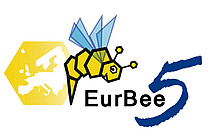„EurBee 5“ - 2012
Beitrag - Modul 1
Poster P5.43 - Dose and duration - what makes the poison? Performance of thiacloprid exposed bee colonies in a long-term trial.
SIEDE R., FAUST L., MEIXNER M., MAUS C., GRÜNEWALD B., BÜCHLER R.
E-Mail: reinhold.siede@llh.hessen.de
Abstractband (Pathology, S. 237):
Residues of the insecticide thiacloprid can be found in nectar and pollen. Its bee toxicity is low but there are concerns related to possible long-term effects. With the goal to investigate potential chronic effects, 30 colonies were started as shook swarms in July 2011, divided in three groups (K, T1, T2) of ten colonies each and arranged in an experimental yard. From July to October control group K was fed with 25L pure syrup per colony. The treatments T1 and T2 were provided with syrup spiked with 200ppb or 2000ppb thiacloprid respectively. Colonies were weighed and number of bees were estimated in intervals of 21 days according to the Liebefeld method. Dead bees were counted regularly. Infestation with Varroa and Nosema was measured. During the feeding period 2011 the groups were statistically indifferent for the above mentioned parameters (general linear model, repeated measures). By contrast, the number of brood cells differed significantly (p<0.05). During winter no colony died. The number of dead winter bees on the bottom boards were similar across the groups (p>0.05). In 2012, T2 was the least productive group, but statistical evaluation did not identify significant differences for the parameters bees, brood, weight and queen losses. These preliminary observations do not support the hypothesis of an impact of a chronic exposure on colony vitality. However, final conclusions will be drawn in 2014, only, after two additional runs in 2012 and 2013.
Beiträge - Modul 2
Poster P1.4 - Effects of chronic neonicotinoid exposition on the development of individual honeybee larvae and colonies.
SCHILD H-A., FISCHER J., ROSS A., GRÜNEWALD B.
E-Mail: hedischild@googlemail.com
Abstractband (Neurobiology, S. 177):
Neonicotinoids are insecticides that are widely used in agriculture. Honey bees can be exposed to those chemicals during foraging. We investigate the influence of non lethal doses of three common neonicotinoids, clothianidin, imidacloprid and thiacloprid, with two different test methods. Colonies were artificially fed with the insecticides and honeybee larvae where in vitro reared under influence of the insecticides. The treatment of the colonies revealed an influence on the amount of foraged contaminated sugar water, containing the different neonicotinoids, and the weight development of the colonies over time. Clothianidin led to an increased foraging activity and thereby also an increasing weight. Imidacloprid and thiacloprid had the opposed effect, reducing the amount of collected sugar water accompanied by a loss of weight. While the concentrations of thiacloprid tested in this study had no influence on the mortality rate of artificial reared honeybee larvae, clothianidin had complex effects on the development of larvae. The two lowest tested concentrations (0.23 ppb, 2.25 ppb) seemed to have an positive effect on the survival time, but the two highest tested concentration had negative effects. To monitor the food uptake of the larva regarding the different treatments we are developing a new method to determine larvae gut´s contents.
Our long-term goal is to relate the effects on colony development to the effects on brood development and vice versa.
~ ~ ~ ~ ~
Poster P1.9 - Effects of neonicotinoid insecticides on the muscle activity of the honeybee.
TRILTSCH M., FISCHER J., KABAT VEL JOB K., GRÜNEWALD B.
E-Mail: m.triltsch@stud.uni-frankfurt.de
Abstractband (Neurobiology, S. 180):
Neonicotinoid insecticides act as agonists of the insect nicotinic acetylcholine receptor. Applications of sublethal insecticide doses lead to various motor abnormalities in honeybees. Here, we investigated the effects of clothianidin, imidacloprid, or thiacloprid on the motor activity of bees. In a first approach we monitored their movement in a small arena before and after being fed with sugar water containing clothianidin or thiacloprid. We observed increased motor activity after clothianidin and a decreased activity after thiacloprid-treatment.
To analyze the effects on motor activity we recorded electromyograms of the muscle M17 before and during insecticide perfusion. Muscle spikes and proboscis extension reactions were elicited by stimulating the antennae and the proboscis with sugar solution. We investigated neonicotinoid-induced changes by determining spikes at different intervals after substance application. Insecticide or phosphate-buffered saline (1µL) was pipetted onto the brain. Our results showed that clothianidin (1µM) increased the muscle activity and in some animals even led to continuous spiking without sugar stimulation. By contrast, imidacloprid and thiacloprid (both 1µM) reduced the spike activity during the whole recording period (1h). Our results, although preliminary, indicate distinct effects of the various insecticides on honeybee motor activity. Tone of the next steps will be to study, whether neonicotinoids act on neurons, muscles or both.
Beitrag - Modul 3
Vortrag 5.29 - Optimised spray application in oilseed rape - effects on nectar and pollen contamination.
WALLNER K., HEINKEL R., MAUS C., TRITSCHLER M., FRIESSLEBEN R., BLOCK T., KRIEG V., EBBINGHAUS D.
E-Mail: Klaus.Wallner@uni-hohenheim.de
Abstractband (Pathology, S. 116):
Oilseed rape is one of the most important agricultural crops in Germany (cropping area >1.5 mio ha), and likewise of key importance in beekeeping as early-season bee forage. To prevent losses of yield, oilseed rape has to be treated with different pesticides during blooming season. The application of pesticides into the blossoms has led to residue findings in honey which caused concerns by beekeepers. We present a concept to optimise pesticide application technology, towards minimization of exposure of bees to pesticide residues in treated blossoms. The under-leaf application technology is a modified system (Dropleg) that has been used in vegetable crops for several years. In semi-field and field trials in 2011 and 2012 it was tested in how far under-leaf spray with the Dropleg system in flowering oilseed rape can reduce pesticide residues in nectar and pollen collected by exposed bee colonies in comparison to conventional application technology. Pollen loads and stored nectar of experimental bee colonies were sampled at different points of time after application and analysed for pesticide residues. As model substances, a systemic fungicide and a non-systemic insecticide were applied, in 2012 additionally a systemic insecticide. First results from 2011 suggest that Dropleg application can significantly reduce pesticide exposure of bee colonies. The project is conducted in the scope of the FitBee Project supported by German BMELV and will be continued until 2014.
Beitrag - Modul 4
Poster P5.46 - A rapid and cost efficient assay to detect multiple honeybee pathogens.
STOLLE E., MORITZ R.
E-Mail: eckart.stolle@zoologie.uni-halle.de
Abstractband (Pathology, S. 238):
The decline in densities of honeybee colonies is a major issue for pollination services in natural ecosystems and agricultural landscapes in numerous regions in the world. As there have been serious colony losses due to honeybee pathogens, the detection and monitoring of such pathogens is crucial. Apart from some invertebrate parasites, such as different mites, wax moth or small hive beetle, there are numerous microbial organisms exploiting the honeybee as a host. Although several molecular assays were published to detect those bacteria, fungi or viruses, a comprehensive, reliable and efficient test is still needed for rapid large scale screens. We developed a rapid and cost-efficient system to detect numerous pathogens in single reactions. The PCR based test has been optimised for high efficiency regarding costs, time and workload.
We aim at detecting eleven viruses in 2-4 multiplex reactions, of which one, containing some of the most common viruses, is established. Using our approach, an extracted RNA sample can be screened and analysed within 3 hours. Furthermore we investigated the potential to obtain semi-quantitative data. In addition to viruses, we also work on an assay to detect several bacterial and fungal pathogens in a similar fashion.
Beitrag - Modul 7
Vortrag 5.26 - The female sex pheromone of Varroa destructor – prospects for a biological control?
ZIEGELMANN B., ROSENKRANZ P.
E-Mail: Bettina.Ziegelmann@uni-hohenheim.de
Abstractband (Pathology, S. 112):
Mating of Varroa destructor occurs exclusively within the sealed honeybee brood cell between the mature male offspring and usually the youngest of the 1-3 daughter mites as soon as they reach maturity. By extracting young attractive females we could prove in a laboratory bioassay that the male mating behaviour is elicited by a volatile sex pheromone that is released by the female shortly after the adult molt. Within the cooperation project “FITBEE” we now aim for developing a biological control of V. destructor based on the female sex pheromone. After fractionating the total extracts of attractive females we reduced the number of potential active compounds to six substances and finally identified the qualitative composition of the Varroa sex pheromone as long chain fatty acids and the corresponding ethyl esters. Bioassays with pure substances revealed that all six compounds elicit the male mating behaviour. In further experiments we tested the pure substances in different dosages and performed first trials to evaluate the potential of the Varroa sex pheromone for disturbance of the mating process. So far, an “overdose” of synthetic pheromone did not reveal a repellent effect. However, males were quite confused finding a suitable mate when exposed to the pheromone blend in the presence of an entire “Varroa family”. This result is promising with regard to the further development of a mating disruption technique.

